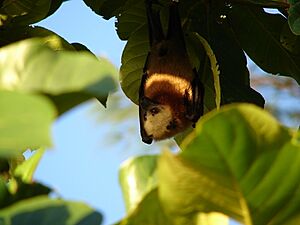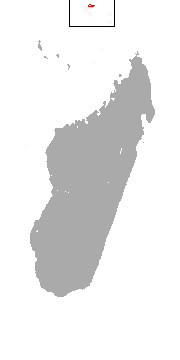Aldabra flying fox facts for kids
Quick facts for kids Aldabra flying fox |
|
|---|---|
 |
|
| Conservation status | |
| Scientific classification | |
| Genus: |
Pteropus
|
| Species: |
aldabrensis
|
 |
|
| Aldabra Flying Fox range | |
| Synonyms | |
|
Pteropus seychellensis ssp. aldabrensis True, 1893 |
|
The Aldabra flying fox (Pteropus aldabrensis) is a type of megabat. Megabats are also known as fruit bats. This special bat lives only on the Aldabra Atoll in the Seychelles islands. When an animal lives only in one specific place, it is called endemic.
Contents
Discovering the Aldabra Flying Fox
Who Named This Bat?
The Aldabra flying fox got its scientific name in 1893. An American biologist named Frederick W. True gave it this name. He worked as a curator at the United States National Museum. This museum is now part of the Smithsonian Institution.
How Scientists Found It
Frederick W. True described the species using two bat specimens. These specimens were collected in 1892. They were found by William Louis Abbott, an American doctor and naturalist.
What Does the Aldabra Flying Fox Eat?
A Fruit-Loving Bat
Like other megabats, the Aldabra flying fox is a herbivore. This means it only eats plants. It loves to eat fruit from different trees. These include evergreen trees like Calophyllum inophyllum and Mystroxylon aethiopicum. It also enjoys fruit from the Indian almond and various fig trees. Some fig trees it eats from are the giant-leaved fig, Ficus rubra, and Ficus reflexa.
Other Plant Foods
Besides fruit, this bat also eats other parts of plants. It has been seen eating flowers from coconut trees and sisal plants. It also eats the leaves of the grey mangrove tree. Sometimes, it even licks sweet honeydew. This honeydew is made by tiny scale insects that live on fig trees.
Where Do Aldabra Flying Foxes Live?
Their Natural Home
The Aldabra flying fox lives in specific natural habitats. A habitat is the natural environment where an animal lives. These bats prefer warm, wet areas.
Types of Habitats
They live in tropical mangrove forests. These forests grow in salty water along coastlines. They also live in tropical dry shrubland. This is an area with many shrubs and bushes, but not a lot of tall trees.
Protecting the Aldabra Flying Fox
Why They Are Vulnerable
The Aldabra flying fox is considered a "vulnerable" species. This means it is at risk of becoming endangered. The IUCN (International Union for Conservation of Nature) classifies species this way.
Main Threats to the Bats
There are a few reasons why these bats are vulnerable:
- They have a very small living area.
- They face threats from natural disasters. Strong tropical cyclones can harm their homes.
- Rising sea levels due to climate change also threaten their habitat.
A Rare Bat
A biologist named A.M. Hutson once said the Aldabra flying fox is "one of the rarest bats in the world." In 1968, scientists estimated there were only about 250 of these bats left.


